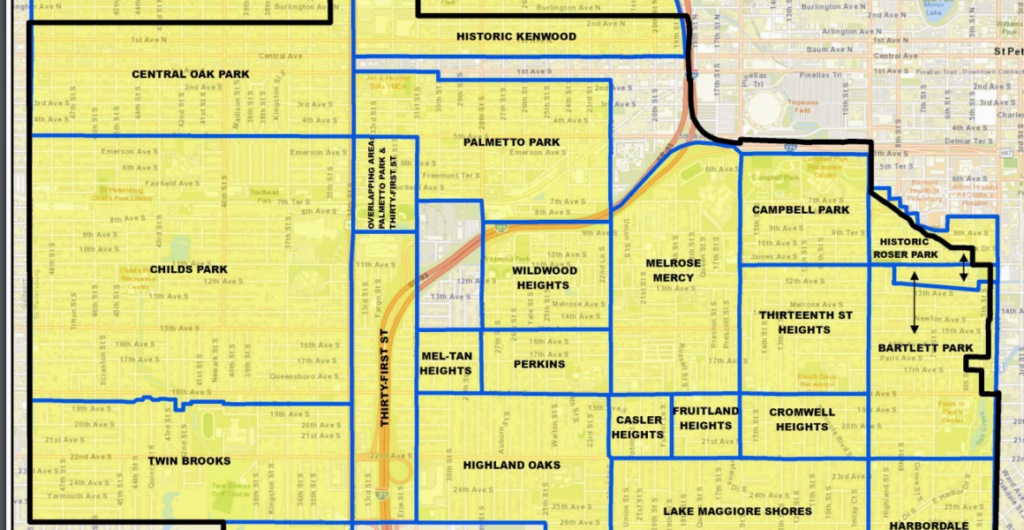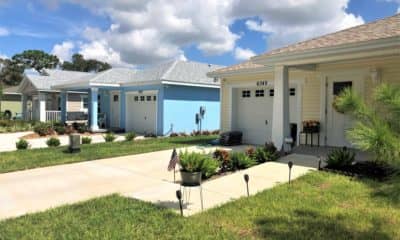Thrive
South St. Pete program receives tax financing approval

Several neighborhoods in the South St. Petersburg Community Redevelopment Area (CRA) will now receive tax increment financing (TIF) to enhance infrastructure and amenities and improve quality of life.
St. Petersburg City Councilmembers unanimously approved utilizing TIF funding for the new Neighborhood Planning Program and including the initiative in the South St. Pete CRA during Thursday’s meeting. The program will fund and assist with planning and expanding neighborhood association operations and community engagement.
The Neighborhood Planning Program (NPP) includes several neighborhoods from Historic Kenwood south to Clam Bayou. The CRA also runs from Childs Park at its westernmost portion east to Bartlett Park. Cassidy Mutnansky, economic development coordinator for the city, explained the TIF funding would support public infrastructure projects consistent with the goals and objectives of accepted plans, reduce blight and strengthen community identity.
“Essentially, the plan did call for reinvigorating neighborhood associations,” said Mutnansky. “We wanted to work with neighborhood residents on identifying their future needs.”

A map of neighborhoods included in the Neighborhood Planning Program. Screengrab.
Funding-eligible projects fall into four categories: beautification, streetscaping and placemaking; multimodal transportation and mobility; parks, greenspaces and recreational facilities; and community development and neighborhood safety.
Program officials will use implementation money for “hard” infrastructure, planning and engineering studies and site acquisition and development. According to city documents, the money will not go towards moveable objects, events, typical neighborhood association operating expenses or political signage.
Mutnansky noted the NPP also aligns with the city’s Vision 2050, Complete Streets and Integrated Sustainability Action Plan.
“So, we were really trying to make sure this is an implementation mechanism for city plans in general,” she said.
Some of the listed neighborhoods, explained Mutnansky, no longer have active associations but were historically located in the South St. Pete CRA. She said the program’s overall intent is reinvigorating community planning to identify priorities and reflect a shared vision.
Increased organization capacity and engagement, added Mutnansky, will help improve the quality of life in underserved neighborhoods, specifically in areas without active associations to help support those efforts.
Mutnansky said NPP officials are utilizing data on code violations, crime, building permits and potential investments to create an informed framework of program priorities.
“We’re anticipating about three neighborhood plans to start, along with some community engagement work,” she said.
Planning recommendations would go to the South St. Pete Citizens Advisory Council for acceptance before the council’s final approval.
While the city will now allocate TIF funding for the program, Mutnansky said, “that does not mean we’re not going to be looking for other money in other places to fund the implementation of neighborhood plans, which we already do.
“We want to implement these plans,” she added. “These neighborhoods work really hard on these plans, and they should be able to implement them.”
Mutansky relayed specific funding examples, including street furniture and lights, public art and planting trees along roads. She said “traffic calming” in areas where kids tend to play in the street, sidewalk expansions and infrastructure improvements for those with disabilities would also be eligible.
City documents state that each neighborhood plan could cost between $100,000 to $150,000, depending on the project’s scope. The FY23 budget includes funding for “at least” three neighborhood planning efforts. It does not encompass implementation.
Susan Ajoc, community services director, said that money would go to planning consultants rather than community engagement. Following CAC approval at its Nov. 1 meeting, NPP officials will bring an approximately $600,000 budget request to the city council Nov. 10.
“As we go through this process with the economic development staff to update those plans, we also have separate dollars for neighborhood enhancements,” said Ajoc. “So, there may be opportunities for us to provide additional money, depending … on the timing for the CRA dollars budget.”
For example, she said the Campbell Park neighborhood plan update was previously approved, and officials will fund implementation through the NPP budget and Penny for Pinellas dollars. Ajoc added they have around $50,000 and are working with the stormwater department to address sidewalk issues.
She explained that a consultant also contributed to the Campbell Park plan and will allow officials to ascertain the difference between utilizing outside sources and conducting the work “in-house.”
Councilmembers unanimously approved resolutions approving the NPP as a new tax increment financing program for the South St. Pete CRA.







